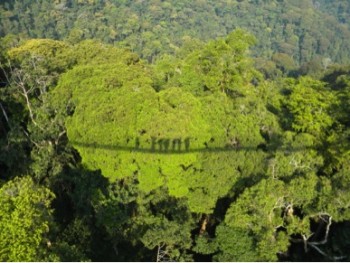Shortly after sunrise we walked a few kilometers to the bus station in Musanze town. To Kigali we go. Amandine Erikson (U. of Indianapolis), Meredith Killough (GWU) and I would spend the next two hours careening down some the highest mountains in Africa on an overcrowded bus while taking in the most beautiful views in the world. The Mountain Gorilla Skeletal Project was going on vacation.
We made it to Kigali, the capital city of Rwanda, with only minor nausea. We struggled through the masses at the bus station in hopes of finding a vehicle traveling to the southwestern corner of the country. Our destination was Nyungwe Forest National Park, but we needed to find our way to Peace Lodge in the border town of Cyangugu first. The second leg of the journey proved to be a bit longer than expected but the ever-changing landscape kept my eyes and mind busy. We arrived at the guesthouse after dark, had chai and chapatti, and prepared for the day to come.
We awoke to a cold morning on the shore of Lake Kivu, one of Africa’s great lakes. Our driver met us at dawn after sharing a quick meal of fried dough, bananas and coffee. Together we drove through the mist toward the forest for the first adventure of the day. Nyungwe Forest National Park feeds both the Congo and Nile rivers and is home to 13 species of primates (25% of Africa’s total primate population), about 280 bird species, and over 150 types of orchids, many of which are endemic to the region. To say I felt lucky to be surrounded by such rich biodiversity is an understatement.
At about 2,500 meters above sea level, even a casual stroll through the forest leaves you breathless. We reached our destination just as the mist and the cold lifted from the forest. We would soon cross a narrow suspension bridge 90 meters long and 50 meters above the forest floor. We said goodbye to our tree snake friend on the platform and stepped out onto the bridge. We had a bird’s eye view of the rainforest canopy, swaying in the breeze like nervous apes on a canopy walk.
Back on land, and after enjoying local snacks of roasted peanuts and butter cookies, we were off on the second leg of our adventure: chimp tracking. We needed to drive to Cyamudongo forest, a small satellite forest of Nyungwe, surrounded by green fields of Rwandan tea.
Compared to the long-term study sites of Gombe or Mahale, the Nyungwe chimps have only been habituated for a short time. The semi-habituation of the chimpanzees combined with the steep, slick terrain of a mountainous rainforest made for a challenging trek. We began hiking through the dense vegetation, and after a few words were exchanged in Kinyarwanda over walkie-talkies, we were running. Presumably toward chimpanzees, but who really knows.
After a precarious decent through the forest, we heard the unmistakable sounds of chimpanzees. A few individuals hung scattered in the trees, obscured by green, making calls to one another. The group moved off, quickly, and we took to the trail once again. This time the group was quieter upon our arrival, eating figs from the tall trees above us. The only interruption was the arrival of an ancient-looking hornbill flying overhead. We spent twenty magical minutes with the chimpanzees before turning back.
We only spent one day in the forest. But this day was worth every second of trouble to get there, including being used as a pillow for hours in an already claustrophobic seating arrangement.
If you are traveling to Rwanda, consider a trip to Nyungwe. You won’t regret it.
Further Information:
The Nyungwe Nziza Project
The Mountain Gorilla Skeletal Project


